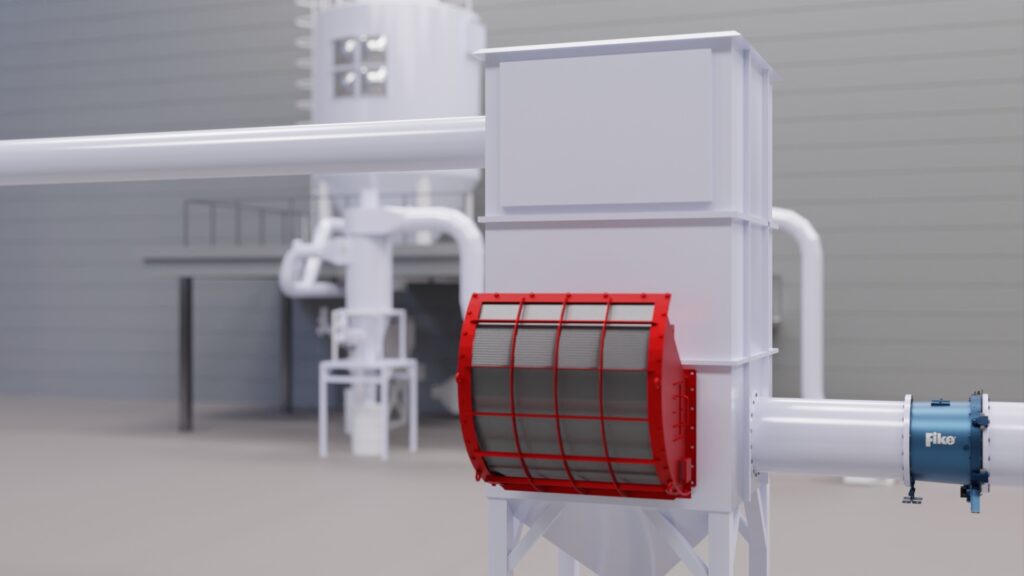
Explosion protection solutions in powder-handling processes
July 11, 2023
By Jim Vingerhoets
 Fike FlameQuench II SQ Flameless Vent (Red unit), and DFI Explosion Isolation Flap valve (Blue unit). All fully tested and NFPA compliant passive explosion protection. Photo: Fike.
Fike FlameQuench II SQ Flameless Vent (Red unit), and DFI Explosion Isolation Flap valve (Blue unit). All fully tested and NFPA compliant passive explosion protection. Photo: Fike. Due to their function of collecting or storing dust, concentration of airborne fine product and presence in nearly every powder handling process, dust collection systems are often the primary source from which a dust explosion may initiate.
When a dust deflagration takes place in a confined volume, the explosion pressure quickly increases. If the dust collector’s design strength – or maximum allowable working pressure (MAWP) – is exceeded, structural damage occurs, releasing hazardous pressure and flame into the surrounding atmosphere.
The weakest areas of the dust collector structure, often access doors and connected piping, are the first to fail and may become projectiles, causing significant damage. Unburnt material will also be blown into the surrounding atmosphere, creating a fireball which can equal 75 times the volume of the dust collector itself. In most cases, dust collectors are connected to other systems, and the explosion can propagate through the process piping and ductwork, causing devastating secondary explosions throughout the production plant.
Preventive measures such as anti-static filter material, ground-monitoring systems, and spark-detection and spark-suppression systems on the dust collector inlet will reduce the risk of a dust deflagration event occurring. However, these methods are not fail safe and create the need to implement reliable protection systems to mitigate the potential catastrophic consequences of a dust explosion.
Suitable protection can be achieved with either passive or active explosion protection systems. Often the more cost-effective solution, passive systems use the energy release of the explosion to mitigate its hazardous consequences. However, in installations where passive venting or flameless venting may not be appropriate due to installation considerations or the presence of harmful or volatile chemicals, an active explosion protection system can be used.
Unique considerations for protecting dust collectors
Explosion protection systems are rarely “one-size-fits all.” Every dust collection system has unique variables, including its type of processed dust and environmental factors, as well as its own geometry that may physically divide the hazard volume into pockets or partial volumes that each require a venting or suppression scheme.
Other areas that must be considered during the explosion protection system design of a dust collector include:
- filter elements that block part of the venting path and create a reduced venting efficiency.
- baffle plates at the dust collector inlet, which protect the filter elements against damage by heavier particles, but also obstruct venting paths or injected suppression powder.
- collection of hybrid mixtures, consisting of dust intermixed with requires protection for the clean air plenum against a potential vapour explosion, if the vapour concentration is within flammable concentration.
- correct positioning of explosion pressure sensors, so they are as close as possible to the area where ignition is expected but do not activate by operational disturbances, such as automatic filter cleaning routines.
- it shall not be forgotten to prevent explosion propagations out of the dust collector to connected equipment by the use of passive or active explosion isolation systems.
Failure to identify these unique variables and to factor them into the final design may lead to catastrophic failure if a dust explosion were to occur.
Fike helps both manufacturers and plant managers across all industries that handle combustible dust by providing custom explosion protection solutions – including consultancy, system design and globally certified products. Learn more at www.fike.com.
Jim Vingerhoets is a global product manager, explosion protection for Fike Corporation. Jim has been with Fike since 2007. Based in Fike’s European office in Herentals, Belgium, Jim is an active working member of European Standardization Committee CEN TC 305 WG3. He has co-ordinated multiple research activities and equipment qualification tests at several international test sites and lectures regularly on the subject of dust explosion protection. Jim.Vingerhoets@fike.com
This article is part of Dust Safety Week 2023. To read more articles on dust safety, click here.
Print this page